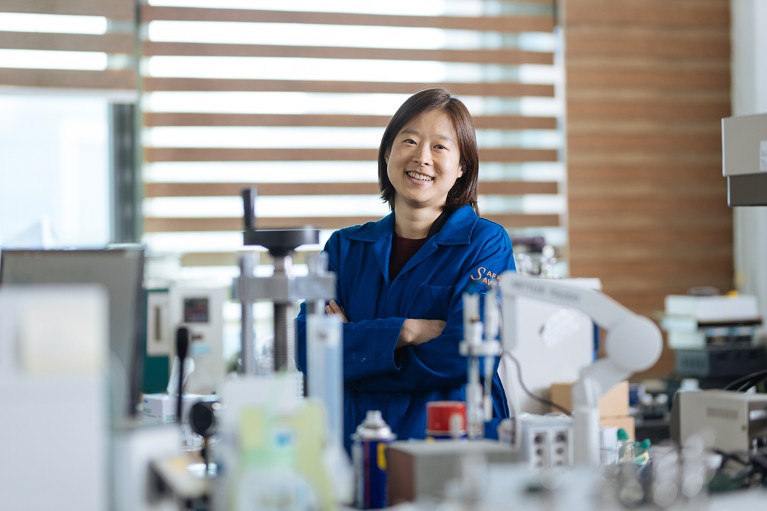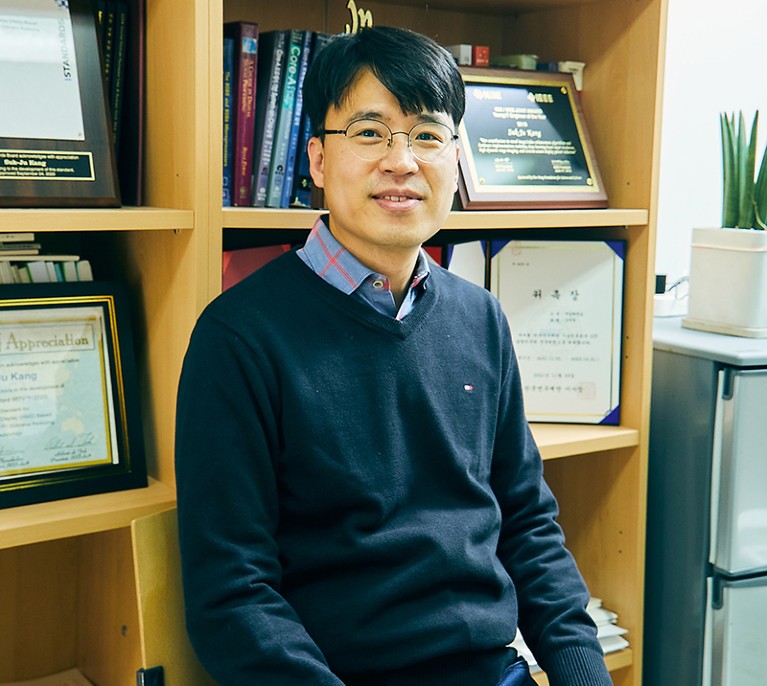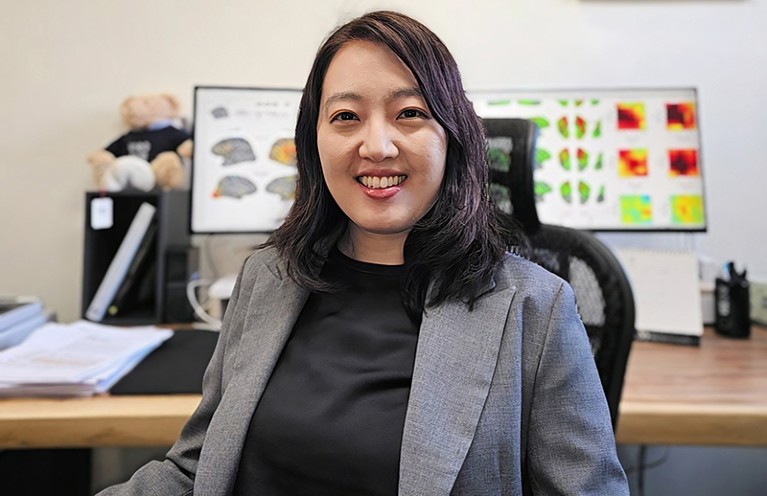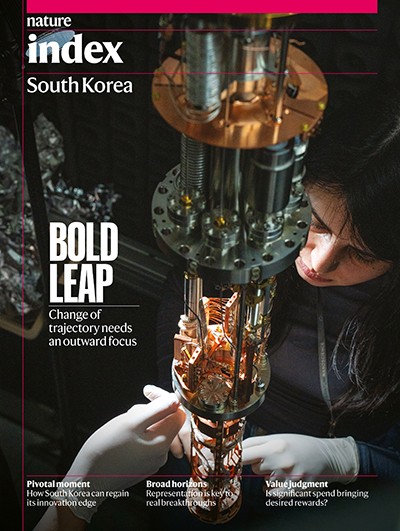In the highly competitive environment of South Korean science, these rising stars stand out. They discuss highlights of their work so far, and how the country might address the many challenges faced by its early career researchers.
HYE RYUNG BYON: Power packer

Hye Ryung Byon, who works on materials for next-generation batteries, wants a clearer career pipeline for younger scientists.Credit: Yoon Hong Gi
The race is on develop alternatives to lithium-ion batteries that can charge quicker, last longer and pack more energy into a smaller space. Hye Ryung Byon, an electrochemist at the Korea Advanced Institute of Science and Technology (KAIST) in Daejeon, and her team are developing technologies and materials for use in next-generation batteries. These include lithium-air batteries, which contain a lithium-metal anode and a cathode that pulls in oxygen from the air and binds it to lithium to generate energy, before releasing it again when the battery recharges. Because this set-up doesn’t require space inside the device to store the cathode ingredient, such batteries have “at least three times higher energy density” compared with their lithium-ion counterparts, says Byon. In one of her most cited works1, Byon and her colleagues demonstrated how using ruthenium oxide (RuO2) nanoparticles as a catalyst can boost the electrical efficiency of lithium-air batteries by up to 73%.
Nature Index 2024 South Korea
Byon began working on energy-related areas, including batteries, capacitors and electrocatalysis, at the Massachusetts Institute of Technology in Cambridge, Massachusetts, after gaining her PhD in her home country of South Korea. “I developed a preference for more practical applications and believed that they lay in fields related to energy,” she says. Byon moved to Japan from the United States in 2011 to run her laboratory at RIKEN, one of the country’s leading research institutions, before moving it to KAIST in 2016.
Byon is also interested in the potential of redox-flow batteries, a type of rechargeable battery that stores energy in two large tanks of liquid electrolytes, for use in grid-scale energy-storage systems. Vanadium, a metal that is typically used as the electrolyte, is expensive to source, so researchers are investigating organic materials as a cheaper and more sustainable alternative. Such materials tend to produce reactive byproducts when a battery is charged or discharged, however, which can reduce the battery’s stability and lifespan. Many also tend to be less soluble than vanadium, translating to lower energy storage. To address this, Byon and her colleagues worked with an organic material called naphthalene diimide, and designed a soluble and stable version that could be used as an electrolyte material2.
Byon says there have been periods in her career when her experiments have failed to produce results or were unable to be completed due to design flaws. She reflects that she “should have dedicated more time to expanding my knowledge beyond my immediate research focus, because breakthrough ideas often emerge from tangentially related fields”. Byon says her experiences have highlighted the “insufficient social support and protection for scientists and their jobs”, and emphasizes the importance of providing South Korean scientists with a clearer pipeline of career opportunities, as well as access to competitive salaries and recognition for their contributions to society. “Hopefully, these efforts will attract more individuals to the field and foster a thriving scientific community,” she says.
Women, in particular, face additional pressures, says Byon. “Although the government has encouraged childbirth and provided some monetary incentives, it’s difficult to develop careers while looking after an infant in our highly competitive and conservative society,” she says. The current institutional system just doesn’t support young working mothers, Byon adds. “In many cases, women scientists delay marriage or children until they get to a stable position in their job.” — Sandy Ong
SEUNG HWAN CHO: Molecule maker

Seung Hwang Cho (right), pictured with student Semin Lee.Credit: Yunhui Jang
Seung Hwan Cho draws inspiration from being able to synthesize materials and products, almost from scratch. “I fell in love with the beauty of making something new,” says Cho, an organic chemist at Pohang University of Science and Technology in Pohang. “Only chemistry lets you do that.”
A key focus of Cho’s lab is designing new types of organoboron compounds — versatile building blocks with applications in agriculture, pharmaceuticals, plastics manufacturing and other industries. A type of organoboron compound, called 1,1-diborylalkanes, has become popular among organic chemists because it can be used in reactions that involve transition metals, a group of chemical elements that includes iron, copper and platinum. Transition metals play an important role in the types of chemical reactions that Cho and his peers are interested in, especially those that are inherently more challenging to pull off, he says.
Another attractive trait of 1,1-diborylalkanes is that they can facilitate chemical reactions that do not include any transition metals at all. These types of reactions are useful in the development of new pharmaceuticals, as metals can leave behind impurities that are tricky to remove. “Expanding the scope of reactions using this method is one of the goals of our research group,” says Cho.
As a leader, Cho strives to offer his young lab members the kinds of opportunities for experimentation that he benefitted from in his early years. He recalls how even as an undergraduate student at KAIST, he was allowed to set his own lines of enquiry, which fuelled his appetite for discovery. Staying nimble and innovative will help South Korean scientists distinguish themselves from the global competition, he says, especially at a time when student numbers and research budgets are low. “We need to focus on groundbreaking discoveries and exploring new research areas,” says Cho.
Aside from having access to more funding, Cho believes early-career scientists in South Korea would benefit from having more mentorship and leadership programmes. “Traditionally, Korean society places a strong emphasis on hierarchical order, which can sometimes hinder open communication and feedback between junior and senior researchers,” he says. Moreover, having a diverse incentive system that rewards exceptional young scientists will also aid in their professional development and prevent brain drain, says Cho. “Ultimately, creating a supportive and nurturing environment that values creativity, innovation and collaboration will be key in enabling the next generation of scientific leaders in Korea.” — Sandy Ong
SUK-JU KANG: Brighter picture

Suk-Ju Kang develops video and image-processing technologies for televisions and gaming devices at Sogang University.Credit: Sogang University
A collaborative culture between local technology companies and academic institutions is a major strength of South Korea, says Suk-Ju Kang, an electrical and computer engineer at Sogang University in Seoul. Compared with other countries, such as the United States, where moving from academia to industry can feel like a one-way street, it’s common for researchers in South Korea to move back and forth between these sectors throughout their career, says Kang. This means there is less uncertainty and anxiety around building relationships ‘across the aisle’, which particularly benefits researchers who are working in innovation areas, he says.
At Sogang University, Kang is developing video and image-processing technologies for next-generation televisions and gaming devices — an area that is increasingly using artificial intelligence (AI) to optimize performance and power efficiency. Kang and his colleagues are exploring a technique called super-resolution image reconstruction, which uses AI to convert low-resolution images into high-resolution quality, while keeping power costs low3.
He is also looking at ways to improve displays in virtual reality and augmented reality devices, which often sit very close to the user’s eyes. “Images can be distorted or need to be displayed at ultra-high resolution due to the very close proximity of the display,” says Kang. “Methods to improve image quality are implemented using AI technology, which enhances both the image quality and efficiency.”
Another area of interest for Kang is improving image-processing techniques for stretchable, foldable and rollable displays4. The major challenge in developing such devices is that when the display stretches, the gaps between pixels increase, which results in reduced brightness over that area. “I developed a method that accounts for these changes in brightness per unit area, allowing the pixel brightness to be adaptively adjusted,” says Kang. “This ensures that the display maintains consistent image quality, despite the stretching.”
Kang’s research has caught the attention of South Korean companies such as LG, one of the world’s largest television manufacturers, headquartered in Seoul, where he has worked on display technologies, and Naver Corporation, an Internet technology company headquartered in Seongnam, where he consults alongside his role at Sogang University.
Kang says South Korea is becoming an increasingly competitive environment for scientists. Early career researchers often feel that there aren’t enough senior roles for them to progress to, he says, which could be addressed by increasing the availability of permanent and full-time roles in academia. He adds that young researchers should be given more opportunities to promote their work at conferences and poster presentations, and calls for more initiatives to showcase the country’s female researchers. Kang remains optimistic that real improvements can be made in South Korean science. “We can achieve better outcomes in the future,” he says. — Benjamin Plackett
SUE-HYUN LEE: Measuring memory

Sue-Hyun Lee studies how memories are formed, recalled and updated, at Seoul National University.Credit: Courtesy of Sue-Hyun Lee
A better understanding of how memories are formed and maintained in the brain is important, because this shapes so much of a person’s character and personality traits, says Sue-Hyun Lee, a cognitive neuroscientist at Seoul National University (SNU). “I find memory research fascinating because our sense of identity is based on our accumulated memories,” she says.
Lee’s lab at SNU investigates how memories are encoded, recalled and updated, and how they might be altered during these stages. For example, changes in memory might occur when discussing childhood pictures. “You might remember experiencing one thing, but then your mother tells you that your memory isn’t correct, and gives you some new information,” says Lee. “You now have an updated memory, not the original stored memory.”
Since the 1960s, scientists have known that protein synthesis is required for memory formation, but Lee and her colleagues have shown that certain proteins in the hippocampus are degraded when memories are recalled, which makes them vulnerable to change5. Studying memory-related processes such as these could lead to more effective treatments for post-traumatic stress disorder and other mental-health conditions, says Lee. “We could potentially edit or weaken traumatic event memories.”
Lee is also keen to figure out how recalled memories can affect people’s behaviour. The bridge between the two, she says, is working memory — information that we briefly hold in mind that facilitates learning, problem-solving and other cognitive processes. A very simple example of this is the notion that babies have no regard for money because they have no memories associated with its value. The memories strongly reinforced in adults “drives us to work hard to earn it and treasure it, rather than treating it as mere paper”, says Lee.
Reflecting on her career, Lee says she felt immense pressure to publish prolifically within a short period when she started out as an independent principal investigator. “But researchers, especially in basic science, need time to accomplish something valuable,” she says. “If we can give young scientists patience and time to freely explore new ideas, they are more likely to become pioneers in their field.”
What’s also important in cultivating a supportive research environment, especially for female scientists, is providing greater access to childcare, and to encourage their partners to share in family responsibilities, Lee says. She says she is fortunate because her husband is also a neuroscientist, so he understands the nuances and challenges of the job. But many female researchers have a difficult time managing household and career responsibilities, which makes institutional support key to improving retention rates. “I see many good women researchers give up their careers because of childcare,” says Lee. “But it’s not an easy issue to solve and it doesn’t just happen in South Korea.” — Sandy Ong



